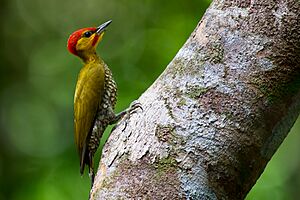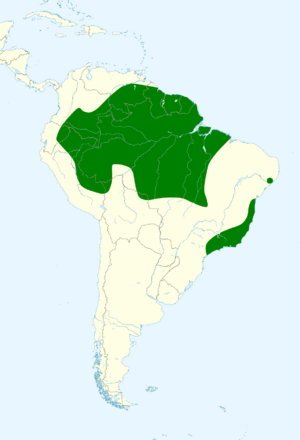Yellow-throated woodpecker facts for kids
Quick facts for kids Yellow-throated woodpecker |
|
|---|---|
 |
|
| Conservation status | |
| Scientific classification | |
| Genus: |
Piculus
|
| Species: |
flavigula
|
 |
|
The yellow-throated woodpecker (Piculus flavigula) is a type of bird from the woodpecker family. You can find it in many South American countries. These include Bolivia, Brazil, Colombia, Ecuador, French Guiana, Guyana, Peru, Suriname, and Venezuela.
Contents
How It Got Its Name
A French scientist named Georges-Louis Leclerc, Comte de Buffon, first described this woodpecker in 1780. He saw a bird from French Guiana. Later, in 1783, a Dutch scientist named Pieter Boddaert gave it the scientific name Picus flavigula.
Today, this woodpecker is part of the Piculus group. This name comes from a Latin word meaning "woodpecker." The second part of its name, flavigula, also comes from Latin. Flavus means "yellow," and gula means "throat." So, its name means "yellow-throated woodpecker."
There are three main types, or subspecies, of the yellow-throated woodpecker:
- P. f. flavigula (named by Boddaert in 1783)
- P. f. magnus (named by Cherrie & Reichenberger in 1921)
- P. f. erythropis (named by Vieillot in 1818)
The P. f. erythropis type looks quite different from the other two. It might even become its own separate species one day.
What It Looks Like
The yellow-throated woodpecker is about 19 to 20 centimeters (7.5 to 7.9 inches) long. It weighs between 44 and 63 grams (1.6 to 2.2 ounces). Both male and female birds look similar, but their heads have some differences.
Male P. f. flavigula woodpeckers have red feathers from their forehead to the back of their neck. They also have red on their cheeks. The rest of their head, including their chin and throat, is bright golden-yellow. Female P. f. flavigula birds only have red on the back of their neck. The top of their head is golden-yellow with green tips on the feathers. The rest of their head looks like the male's.
These woodpeckers have yellowish-green upper bodies. Their wings are mostly brownish-black with some cinnamon patches. Their tail is black with green edges. Their undersides are green. Their breast feathers have white centers and black tips. Their belly and under-tail feathers look striped or scaly with black. They have a black beak with a lighter base, brown eyes, and dark green-gray legs.
Young woodpeckers are duller and greener on their upper parts. Their throat is yellow, but their undersides are darker. Young males might have a small red patch on their head. Young females have a completely green head.
The P. f. magnus type looks just like P. f. flavigula. The only difference is that the male P. f. magnus does not have red on its cheeks.
The P. f. erythropis type is quite different. It is smaller than the other two. Male P. f. erythropis birds have more red on their head. The red on their cheeks also goes around under their chin and throat. Female P. f. erythropis birds have a golden-yellow forehead, cheeks, and throat. They also have some red on their throat. For both sexes, their undersides look more striped than spotted.
Where It Lives
The different types of yellow-throated woodpeckers live in specific areas:
- P. f. flavigula lives in eastern Colombia, southern Venezuela, the Guianas, and northern Brazil.
- P. f. magnus lives in southeastern Colombia, eastern Ecuador, eastern Peru, northern Bolivia, and western Brazil.
- P. f. erythropis lives separately in eastern Brazil, in the states of Pernambuco, Bahia, and São Paulo.
These woodpeckers like to live inside and at the edges of old, moist forests. The P. f. erythropis type often lives in drier forest areas called caatinga. They usually live in lowlands. You can find them from sea level up to about 300 meters (980 feet) high in Ecuador. In Peru, they can be found up to 500 meters (1,600 feet) high.
Behavior
How It Moves Around
The yellow-throated woodpecker stays in the same area all year long. It does not migrate.
What It Eats
This woodpecker looks for food from the middle parts of the forest up to the very tops of the trees. It often searches alone or in pairs. Sometimes, it joins groups of different bird species looking for food together. It finds food by pecking, hammering, and flaking off tree bark. It does not often probe for food. We do not know everything it eats, but we know it eats ants.
Reproduction and Nests
The breeding season for the yellow-throated woodpecker changes depending on where it lives. For example, it breeds in November in Colombia and Venezuela. In the Guianas, it breeds from May to July. In the Amazon parts of Brazil and Bolivia, it breeds from August to December.
The woodpecker digs a nest hole, usually in a tree branch or a tree stump. It often makes its nest fairly close to the ground. Sometimes, it can be as high as 15 meters (49 feet) up. We do not know how many eggs it lays, how long the eggs take to hatch, or how long the young birds stay in the nest. We also do not know much about how the parents care for their young.
Its Calls and Songs
The yellow-throated woodpecker's song is a series of 1 to 7 loud, rough, and angry-sounding "vraah" notes. It also makes loud, hissing calls like "queea" or "shaa, gheh" or "shreeyr." Sometimes, it makes these calls twice. It also has a rattling call that sounds like "kee" repeated many times.
Its Conservation Status
The IUCN (International Union for Conservation of Nature) says the yellow-throated woodpecker is a species of "Least Concern." This means it is not currently in danger of disappearing. It lives in a very large area. However, we do not know how many of these birds there are, and their numbers seem to be going down. No big threats have been found right now. It is quite common in most places, but it is thought to be rare in Ecuador and Peru. It lives in protected areas in several countries.


